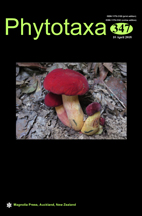Abstract
Synedroid diatoms are morphologically characterized by a putative synapomorphic structure called an ocellulimbus, a terminal pore field whose surface is depressed relative to the rest of the valve surface. Among these diatoms is the genus Hyalosynedra Williams and Round. Characters associated with that genus are bilayered wall construction, densely packed virgae and an asymmetric rimoportula. However, these characters diagnose partially overlapping (incongruent) groups. The apical pore field itself, when present, is sometimes sunken deeply, sometimes weakly and sometimes not at all among these diatoms. Here we make additional morphological observations and add molecular sequence data (nuclear SSU rDNA, rbcL, psbC) to attempt to resolve these apparent conflicts. The molecular phylogeny does not resolve any morphological character without homoplasy, but conversely does resolve taxa which share an asymmetric rimoportula and/or densely packed virgae into a single clade we call the “hyalosynedroid” taxa. This clade contains our representatives of Thalassionematales which had been linked to Hyalosynedra by the bilayered wall structure and the possession by some species of an asymmetric rimoportula. We describe three new genera, and a total of 11 new species. Whereas four species of Hyalosynedra were previously described, we describe three new species of Hyalosynedra, describe the new genus Divergita with three species (one new, one transferred from Synedra and one from Hyalosynedra), and the new genus Stricosus with seven new species. A key to species of Hyalosynedra, Divergita and Stricosus is included.

